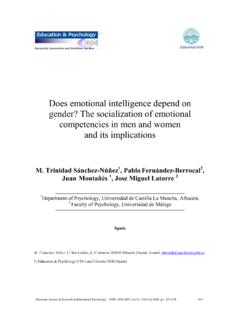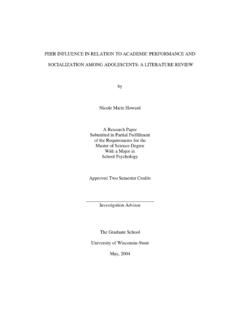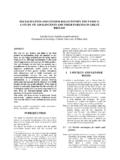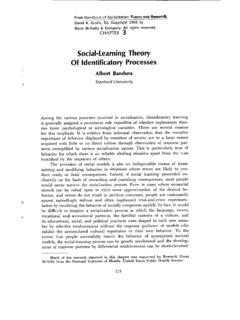Transcription of The Police Culture - SAGE Publications
1 974444 The PoliceCulture Describe the various ways in which the Police subculture conflicts with the offi-cial norms and values of policing. Compare and contrast the various forms of an organization s Culture . Identify and elaborate on variables that influence Police officers acceptance ofthe subculture. Describe the positive aspects of the Police subculture. Identify the sources of Police stress. Highlight the various strategies that both organizations and individual officerscan implement to mitigate the negative effects of job-related stress.
2 Describe the ways that the Police subculture and stress are related. Identify and provide examples of the ways in which community policing can bothincrease and decrease stress levels among Police officers. Describe the characteristics associated with the phenomenon of Police LEARNING OBJECTIVESIn Chapter 4, we focus on organizational and administrative aspects of policing, onthe formal structure and the impact of Police leaders. While these formal consider-ations are crucial to an understanding of the Police role, there are two other con-tributing factors that must be considered in our attempt to understand policing as anoccupation: the Police subculture and the pressures and stresses of Police work.
3 Policeadministrators and the law specify the broad parameters within which officers operate,but the Police subculture tells them how to go about their tasks, how hard to work,what kinds of relationships to have with their fellow officers and other categories ofpeople with whom they interact, and how they should feel about Police administra-tors, judges, laws, and the requirements and restrictions they , the effects of formal pressures and the pressures generated by thepolice subculture often lead Police officers to experience a great deal of stress in theiroccupational, social, and family lives resulting in cynicism, burnout, and retirement,as well as a host of physical and emotional ailments.
4 Further, many officers, at least ini-tially, fail to recognize the extent to which the Police subculture and their chosen occu-pation affect the way in which they view and act toward to Inciardi (1990), Police officers develop resources to deal with the iso-lation from the community that results from the job and the Police socialization Police subcultural attributes include protective, supportive, and shared attitudes,values, understandings and views of the world, which result in a blue wall of silence(p. 227), or closed Police society.
5 Furthermore, this process of socialization or the creationof a blue fraternity begins at the Police academy, but as with most forms of occupationsocialization, it is an ongoing process throughout the Police officer s INTRODUCTION TO POLICING patrol officer is attempting to explain to members of his department sadministrative committee on traffic safety why the traffic accident he was involved in factors interact and are reinforced by other officers, eventually leading to thedevelopment of attitudes, behaviors, beliefs, and perceptions that reflect the dominantbeliefs of almost all Police officers.
6 Ultimately, Police officers cope with their organiza-tional environment by taking a lay low or cover your ass attitude and adopting acrime-fighter or law enforcement orientation (Paoline, Myers, & Worden, 2000, p. 578).They quickly discover that when they are recognized, it is usually for a mistake or a vio-lation, rather than for an achievement or effective policing, and they learn that hard workentails the risk of exposure and sanction. Some believe that the professionalization of thepolice ( , removing politics from policing, scientific advances, and anti- Police miscon-duct strategies) has been the catalyst for this isolation and the strengthening of the us-versus-them attitude associated with the Police Culture (Paoline, Myers, & Worden, 2000, p.)
7 579). Thus, the Police Culture is often viewed negatively, and the blue wall of silence hasresulted in Police officers not being held accountable for misconduct (Frye, 2006).However, it is important we realize that an organizational Culture can have many positiveeffects and can actually reduce anxiety and uncertainty in human relationships and com-municate the ideology that defines what the organization is all about (Champoux, 2006).Most agree that the organizational Culture of a Police department affects the behavior ofthe officers.
8 Thus, the establishment of a professional, moral, ethical Culture in a policeorganization can control, prevent, and punish misconduct and corruption. Of course theestablishment of this type of Culture relies in part on the organization s hiring, retention,promotion practices, leadership, and socialization process for new Police officers. The Police SubcultureAccording to the seminal work of William Westley (1970), the Police subcultureis acrucial concept in the explanation of Police behavior and attitudes. The subculture,in his view, characterizes the public as hostile, not to be trusted, and potentially vio-lent; this outlook requires secrecy, mutual support, and unity on the part of thepolice.
9 Manning (1977) suggested that the inherent uncertainty of Police work, com-bined with the need for information control, leads to Police teamwork, which in turngenerates collective ties and mutual dependency. Traditional characterizations of thepolice Culture have focused on describing the shared values, attitudes, and norms cre-ated within the occupational and organizational environments of policing (Paoline,2004, p. 205). However, some research has begun to investigate the assumptions asso-ciated with a single Police Culture . Paoline (2004) proposed the existence of differentattitudinal subgroups of Police officers.
10 For example, although some groups of policeofficers represent many of the negative attitudes of the traditional Culture , othersoften possess attitudes that would be considered polar opposites. In other words, aspolice departments have become more heterogeneous, a single cohesive Police culturecould be expected to give way to a more fragmented occupational group (Paoline,2003). This expectation is supported by the representation of racial minorities,females, and college-educated personnel who bring to policing different outlooks andattributes based on past experiences that may affect the way in which Police collec-tively interpret the world around them (Paoline, Myers, & Worden, 2000).

















